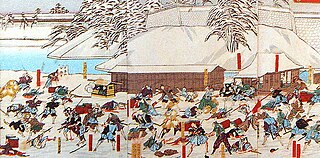
Prince Tokugawa Yoshinobu was the 15th and last shōgun of the Tokugawa shogunate of Japan. He was part of a movement which aimed to reform the aging shogunate, but was ultimately unsuccessful. He resigned his position as shogun in late 1867, while aiming at keeping some political influence. After these efforts failed following the defeat at the Battle of Toba–Fushimi in early 1868, he went into retirement, and largely avoided the public eye for the rest of his life.

Osahito, posthumously honored as Emperor Kōmei, was the 121st emperor of Japan, according to the traditional order of succession. Kōmei's reign spanned the years from 1846 through 1867, corresponding to the final years of the Edo period.

Bakumatsu were the final years of the Edo period when the Tokugawa shogunate ended. Between 1853 and 1867, under foreign diplomatic and military pressure, Japan ended its isolationist foreign policy known as sakoku and changed from a feudal Tokugawa shogunate to the modern empire of the Meiji government. The major ideological-political divide during this period was between the pro-imperial nationalists called ishin shishi and the shogunate forces, which included the elite shinsengumi swordsmen.
The Ansei Purge was a multi-year event during the Bakumatsu period of Japanese history, between 1858 and 1860, during which the Tokugawa shogunate imprisoned, executed, or exiled those who did not support its authority and foreign trade policies. The purge was undertaken by Ii Naosuke in opposition to Imperial Loyalists.

Keiō was a Japanese era name after Genji and before Meiji. The period spanned the years from May 1865 to October 1868. The reigning emperors were Kōmei-tennō (孝明天皇) and Meiji-tennō (明治天皇).

Tokugawa Iemochi was the 14th shōgun of the Tokugawa shogunate of Japan, who held office from 1858 to 1866. During his reign there was much internal turmoil as a result of the "re-opening" of Japan to western nations. Iemochi's reign also saw a weakening of the shogunate.

Tokugawa Iesada was the 13th shōgun of the Tokugawa shogunate of Japan. He held office for five years from 1853 to 1858. He was physically weak and was therefore considered by later historians to have been unfit to be shōgun. His reign marks the beginning of the Bakumatsu period.

Ii Naosuke was a daimyō of Hikone (1850–1860) and also Tairō of the Tokugawa shogunate, Japan, a position he held from April 23, 1858, until his death, when he was assassinated in the Sakuradamon Incident on March 24, 1860. He is most famous for signing the Harris Treaty with the United States, granting access to ports for trade to American merchants and seamen and extraterritoriality to American citizens. He was also an enthusiastic and accomplished practitioner of the Japanese tea ceremony, in the Sekishūryū style, and his writings include at least two works on the tea ceremony.

Yanagisawa Yoshiyasu was a Japanese samurai of the Edo period. He was an official in the Tokugawa shogunate and a favourite of the fifth shōgun, Tokugawa Tsunayoshi. His second concubine was Ogimachi Machiko, a writer and scholar from the noble court who wrote monogatari.

Genji (元治) is a Japanese era name after Bunkyū and before Keiō. This period spanned only slightly more than a single year from March 27, 1864 until May 1, 1865. The reigning emperor was Kōmei-tennō (孝明天皇).

Ansei (安政) was a Japanese era name after Kaei and before Man'en. This period spanned the years from November 1854 through March 1860. The reigning emperor was Kōmei-tennō (孝明天皇).

Kaei (嘉永) was a Japanese era name after Kōka and before Ansei. This period spanned the years from February 1848 through November 1854. The reigning emperor was Kōmei-tennō (孝明天皇).

Hōtoku (宝徳) was a Japanese era name after Bun'an and before Kyōtoku. This period spanned the years from July 1449 through July 1452. The reigning emperor was Go-Hanazono-tennō (後花園天皇).

Chikako, Princess Kazu (Kazunomiya) was the wife of 14th shōgun Tokugawa Iemochi. She was renamed Lady Seikan'in-no-miya after she took the tonsure as a widow. Chikako was the youngest child of Emperor Ninkō.

Hotta Masayoshi was the 5th Hotta daimyō of the Sakura Domain in the Japanese Edo period, who served as chief rōjū in the Bakumatsu period Tokugawa shogunate, where he played an important role in the negotiations of the Ansei Treaties with various foreign powers.

Bunkyū (文久) was a Japanese era name after Man'en and before Genji. This period spanned the years from March 1861 through March 1864. The reigning emperor was Kōmei-tennō (孝明天皇).
Gaikoku bugyō (外国奉行) were the commissioners or "magistrates of foreign affairs" appointed at the end of the Edo era by the Tokugawa shogunate to oversee trade and diplomatic relations with foreign countries. In essence this was the beginning of the creation of a Ministry of Foreign Affairs after Japan's long period of isolationist policy.

Nison-in is a Tendai Buddhist temple complex in Ukyō-ku, a western ward in the city of Kyoto, Japan. The temple's official name is Ogura-yama Nison-kyō-in Keidai-ji. The temple is a popular destination during the Japanese maple viewing season.

The Sakuradamon Incident was the assassination of Ii Naosuke, Chief Minister (Tairō) of the Tokugawa shogunate, on March 24, 1860 by rōninsamurai of the Mito Domain and Satsuma Domain, outside the Sakurada Gate of Edo Castle.
Kōbu gattai was a policy in the Bakumatsu era of Japanese history aiming to strengthen Japan against the perceived "foreign threat" by obtaining a political coordination between the Tokugawa shogunate, certain major feudal domains and the Japanese Imperial Court.














